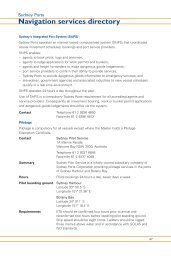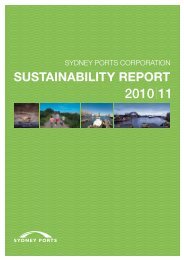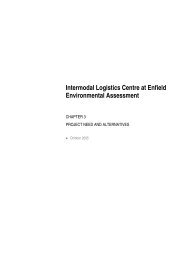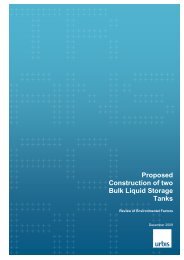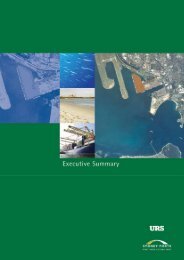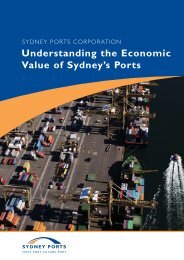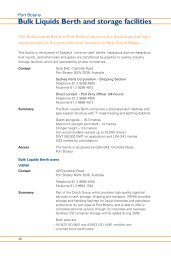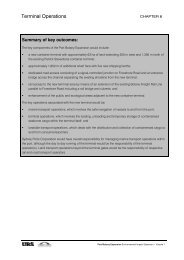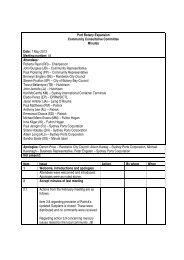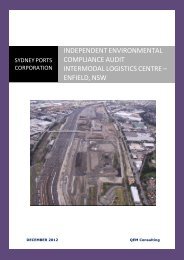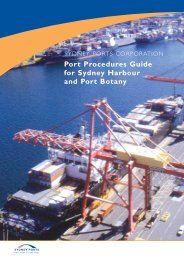SYDNEY PORTS CORPORATION ANNUAL REPORT 12
SYDNEY PORTS CORPORATION ANNUAL REPORT 12
SYDNEY PORTS CORPORATION ANNUAL REPORT 12
You also want an ePaper? Increase the reach of your titles
YUMPU automatically turns print PDFs into web optimized ePapers that Google loves.
52<br />
Sydney PortS CorPoration<br />
noteS to the FinanCiaL StateMentS<br />
note 2. SUmmary of SignifiCant aCCoUnting PoliCieS<br />
(ContinUed)<br />
(iv) Valuation of buildings<br />
Non-specialised buildings, which include commercial and<br />
general purpose buildings for which there is a secondary<br />
market, are valued at fair value. Specialised buildings are<br />
designed for a specific, limited purpose. Where there are<br />
no feasible alternative uses for such buildings, they are<br />
valued at market buying price, the best indicator of which is<br />
the replacement cost of the remaining economic benefits.<br />
Heritage buildings are valued at fair value. Fair value is<br />
represented by market value for existing use, because there<br />
are few or no feasible alternative uses for such buildings.<br />
(v) Revaluation of property, plant and equipment<br />
Revaluations are made with sufficient regularity to ensure<br />
that the carrying amount of property, plant and equipment<br />
does not materially differ from fair value at the reporting<br />
date. Where the Corporation revalues non-current assets<br />
by reference to current prices for assets newer than those<br />
being revalued (adjusted to reflect the present condition of<br />
the assets), the gross amount and accumulated<br />
depreciation are separately restated.<br />
Revaluation increments are credited directly to the asset<br />
revaluation reserve, except that, to the extent that an<br />
increment reverses a revaluation decrement for an asset<br />
previously recognised as a loss in profit or loss, the<br />
increment is recognised as a gain in profit or loss.<br />
Revaluation decrements are recognised immediately in<br />
profit or loss, except that they are debited directly to the<br />
asset revaluation reserve to the extent that a credit exists in<br />
the asset revaluation reserve in respect of the asset. Assets<br />
acquired or constructed since the last revaluation are<br />
valued at cost.<br />
Any revaluation reserve amount in respect of an item of<br />
property, plant and equipment is transferred directly to<br />
retained earnings on disposal.<br />
The most recent revaluation of property, plant and<br />
equipment by the Corporation was completed at 30 June 20<strong>12</strong><br />
and was based on independent assessments.<br />
The revaluation included the following guidelines:<br />
■■ Assets acquired within <strong>12</strong> months of the revaluation date<br />
were assumed to have current values and were excluded<br />
from the revaluation process.<br />
■■ Where one asset in a class was revalued, all assets in<br />
that class were revalued.<br />
■■ Property, plant and equipment (excluding land) was<br />
valued based on the estimated depreciated replacement<br />
cost of the most appropriate modern equivalent<br />
replacement facility having a similar service potential<br />
to the existing asset.<br />
■■ Land was valued on an existing-use basis, subject to<br />
any restrictions or enhancements since acquisition.<br />
Sydney PortS CorPoration finanCial rePort 2011/<strong>12</strong><br />
(vi) Impairment<br />
The Corporation assesses at each reporting date whether<br />
there is any indication that a cash generating unit, or an<br />
asset within a cash generating unit, may be impaired. If<br />
such an indication exists, the Corporation estimates the<br />
recoverable amount. An impairment loss is recognised<br />
where the carrying amount of the asset or cash-generating<br />
unit exceeds the recoverable amount. Impairment losses<br />
are recognised in profit or loss except for assets under<br />
revaluation as the impairment loss will first be recognised<br />
through each asset’s revaluation reserve prior to<br />
recognition in profit or loss.<br />
(i) Intangible assets<br />
Intangible assets acquired separately are initially measured<br />
at cost. Following initial recognition, intangible assets are<br />
carried at cost less any accumulated amortisation and any<br />
accumulated impairment loss. The Corporation’s intangible<br />
assets relate to software and easements.<br />
Subsequent expenditure is capitalised only when it<br />
increases the future economic benefits embodied in the<br />
specific asset to which it relates. All other expenditure is<br />
recognised in profit or loss as incurred.<br />
Easements relate to the Corporation’s interest in land.<br />
Easements are recognised using the historic cost method<br />
rather than fair value as it is assumed there is no active<br />
market for easements.<br />
In-house software development costs are capitalised, while<br />
other costs (including research costs) are expensed in the<br />
statement of comprehensive income in the year in which<br />
the expenditure is incurred. Useful lives are examined on<br />
an annual basis and adjustments, where applicable, are<br />
made on a prospective basis. The Corporation’s software<br />
intangible assets have finite lives and are amortised on a<br />
straight-line basis.<br />
(j) Depreciation and amortisation of assets<br />
Depreciation and amortisation have been calculated on<br />
depreciable assets, using rates estimated to write off the<br />
assets over their remaining useful lives on a straight-line<br />
basis. Land assets have been treated as non-depreciable.<br />
The useful lives of assets were reassessed during the<br />
year with no material changes required. The expected<br />
depreciable lives of new depreciable assets at 30 June 20<strong>12</strong><br />
and 2011 are:<br />
■■ Buildings 10 to 50 years<br />
■■ Roadways and bridges 20 to 100 years<br />
■■ Wharves, jetties and breakwaters 10 to 100 years<br />
■■ Plant 2 to 50 years<br />
■■ Intangibles – software 3 to 6 years<br />
(k) Capitalisation of assets<br />
Assets in excess of $1,000 are capitalised where they are<br />
expected to provide future economic benefits for more than<br />
one reporting period. Only those assets completed and<br />
ready for service are taken to the property, plant and<br />
equipment or intangible assets accounts. The remaining<br />
capital expenditures are carried forward as construction<br />
in progress and are included in property, plant and<br />
equipment in the statement of financial position.



